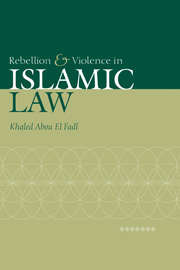Book contents
- Frontmatter
- Contents
- Preface and acknowledgments
- Introduction
- 1 Modern scholarship and reorienting the approach to rebellion
- 2 The doctrinal foundations of the laws of rebellion
- 3 The historical context and the creative response
- 4 The rise of the juristic discourse on rebellion: fragmentation
- 5 The spread of the Islamic law of rebellion from the fourth/tenth to the fifth/eleventh centuries
- 6 Rebellion, insurgency, and brigandage: the developed positions and the emergence of trends
- 7 The developed non-Sunnī positions
- 8 Negotiating rebellion in Islamic law
- Works cited
- Index of names
- Index of subjects
3 - The historical context and the creative response
Published online by Cambridge University Press: 15 December 2009
- Frontmatter
- Contents
- Preface and acknowledgments
- Introduction
- 1 Modern scholarship and reorienting the approach to rebellion
- 2 The doctrinal foundations of the laws of rebellion
- 3 The historical context and the creative response
- 4 The rise of the juristic discourse on rebellion: fragmentation
- 5 The spread of the Islamic law of rebellion from the fourth/tenth to the fifth/eleventh centuries
- 6 Rebellion, insurgency, and brigandage: the developed positions and the emergence of trends
- 7 The developed non-Sunnī positions
- 8 Negotiating rebellion in Islamic law
- Works cited
- Index of names
- Index of subjects
Summary
THE EARLY CONTEXT AND IBN TAYMIYYA'S CLAIMS
Ibn Taymiyya (d. 728/1327–8) accused the fuqahāʾ (jurists) of Kūfa and al-Shāficī (d. 204/819–20) of inventing aḥkām al-bughāh. They did so, he claimed, because they wished to defend cAlī; and so they argued that it was incumbent upon cAlī to fight those who rebelled against him; and that it was incumbent upon Muslims to support cAlī against the rebels. But they carried this beyond the legacy of cAlī, and transformed their position into a legal principle (qācida fiqhiyya). According to this legal principle, they declared whomever they wished to be the just ruler (al-cādil), and those who opposed him to be the rebels (al-bughāh). Then they argued that it was necessary to support the just ruler by fighting against those who rebelled against him. The truth of the matter, Ibn Taymiyya argued, is that nothing had been reported from the Prophet about fighting rebels except for one fabricated ḥadīth. None of the books of ḥadīth refer to fighting rebels; rather, they only refer to fighting the Khawārij and the apostates. These jurists, Ibn Taymiyya contended, confused fitna wars with the bughāh wars, and equated fighting the Khawārij and the hypocrites, which is proper, with fighting unjust rulers, which is improper. Effectively, these jurists opened the door for all types of people to rebel while believing that they were seeking the establishment of justice. The reality, however, is that these rebels spread corruption and caused more damage than good.
- Type
- Chapter
- Information
- Rebellion and Violence in Islamic Law , pp. 62 - 99Publisher: Cambridge University PressPrint publication year: 2001



